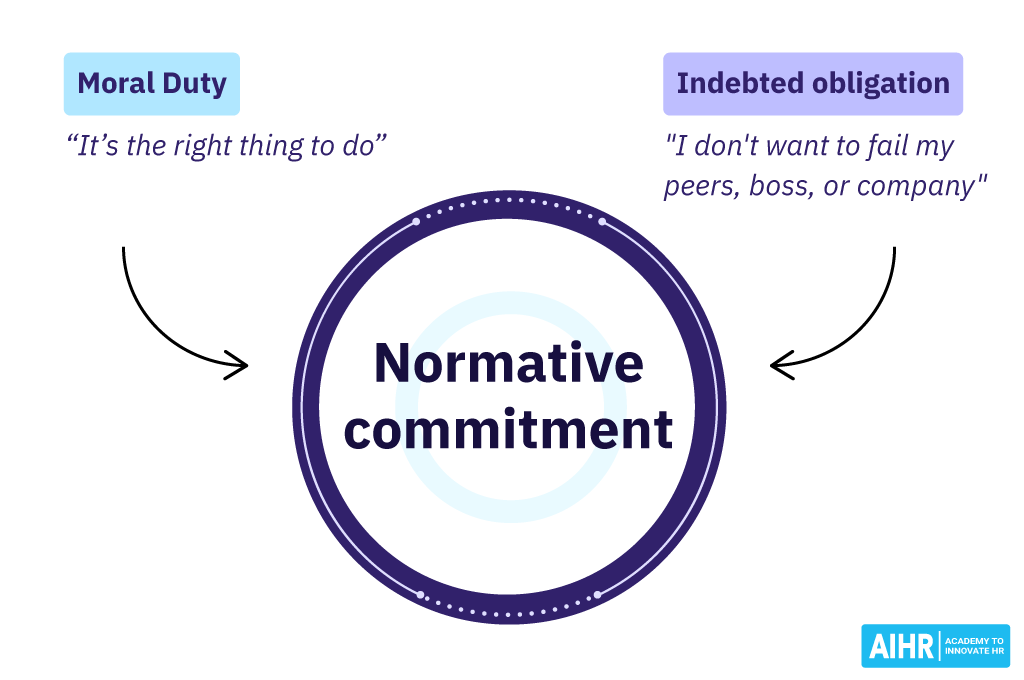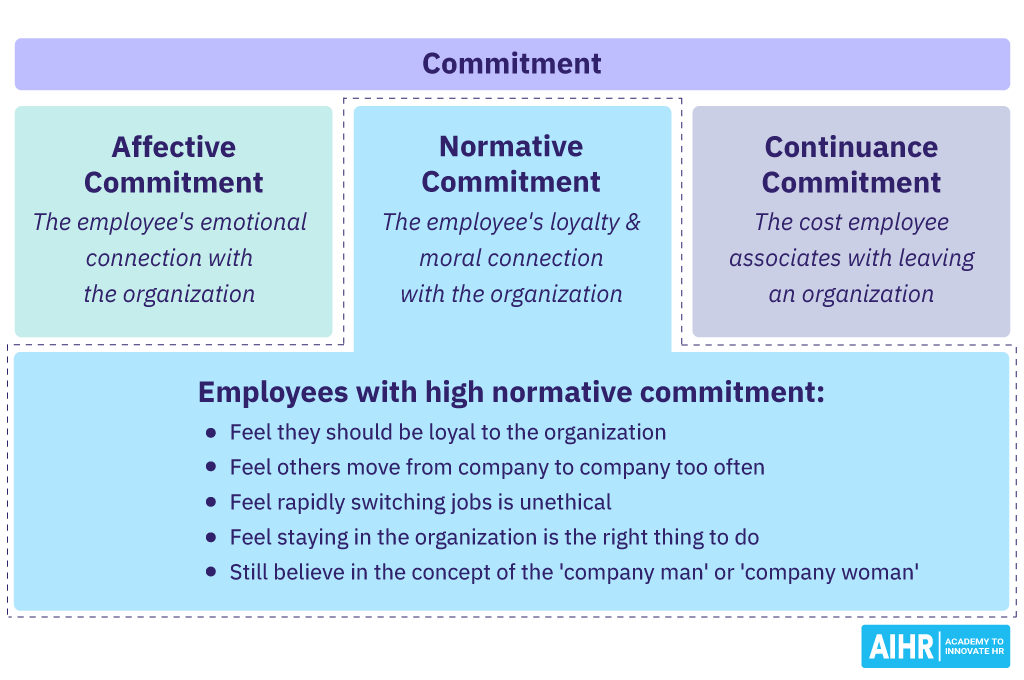Normative Commitment
What is normative commitment?
Normative commitment is a sense of responsibility employees feel for their job or organization that holds them back from quitting. It is a perceived moral obligation to stick with something through thick and thin.
People with high normative commitment:
- Believe they have a responsibility and obligation to stay in their job
- Are less likely to leave when a new opportunity arises
- Would feel guilty about leaving their organization
- Feel a strong loyalty
- Are more likely to go the extra mile in their work
- Feel like they owe the organization.
People can have normative commitment to their organization but also to their profession. For example, a nurse or soldier may feel very strongly about their responsibility to their profession and thus be less likely to switch to a different type of job. An employee who just completed a full trainee program may feel a similar commitment to their employer.
Normative commitment is one of the three components of organizational commitment. The other two components are affective commitment and continuance commitment.
Affective commitment refers to an employee’s emotional commitment to the organization they work for, while continuance commitment is about perceiving the cost of leaving the organization as too high.
Dimensions of normative commitment
Normative commitment has two dimensions.
- Moral duty. A strong sense of desire to pursue a course of action or help because it is the right thing to do.
- Indebted obligation. A strong sense of having to pursue a course of action to avoid the social cost of failing to do so.
An example of moral duty may be a missionary, police officer, or firefighter who sees their job as their calling or life’s purpose.
An example of indebted obligation is a worker who feels like they can’t quit because their company helped them out in a time of need. It might also be someone who feels like they can’t leave their team because they don’t want to fail their colleagues or boss.

Normative versus affective commitment
Normative commitment differs from affective commitment. Affective commitment is the employee’s emotional connection with the organization. As a general rule:
- People with normative commitment feel they should stay.
- People with affective commitment feel they want to stay.
Interventions that only increase normative commitment (feeling like you should stay) but not affective commitment (feeling that you want to stay) are often ineffective. If people feel an obligation without wanting to stay, they are much less likely to do their best or go the extra mile.

Normative commitment and culture
There is a relationship between normative commitment and cultural background. People from more collectivistic cultures (like Brazil and China) feel more bound by their duty and obligation than people in more individualistic cultures (the US and Germany).
In collectivist cultures, normative commitment is more predictive of people staying in their job longer, while in individualistic cultures, affective commitment has more predictive value.
Interventions to increase normative commitment
There are different interventions that an organization can take to increase normative commitment.
- Traineeships. Traineeships are paid programs that help graduates explore different roles to see where in the organization they fit best. Often combined with training and coaching, these programs require significant investment but also create loyalty to the organization.
- Social inclusion and cohesion. Perhaps the easiest way to build commitment is by creating an inclusive environment and building team cohesion. People who rely on their colleagues and bosses will feel more indebtedness, increasing commitment.
- Learning programs. Training programs are an excellent example of the employer investing in the employee. They are an effective way to build indebted obligation. It is, however, essential to frame the training as something given to the employee rather than a way to build organizational capabilities. In the case of the latter, the employee will feel less committed.
- Paid sabbatical. Organizations also use paid sabbatical leave to create commitment. Strategy consulting companies are known for providing paid time off to their analysts to follow an MBA, only for the consultant to return to an associated role for a couple more years.
- Emphasizing the importance of work. By emphasizing the importance of the work the employee does and its impact on other people, the employee will get an increased sense of moral duty. Similarly, if the organization has an aspiring vision and goals, this will also help to create additional commitment.
Again, for each kind of intervention, it is critically important that employees also want to come back. Giving an employee a paid sabbatical while they don’t really want to come back is mostly ineffective.
Measuring normative commitment
Normative commitment is measured as part of the three-component model (TCM), which measures normative, affective, and continuance commitment. This scale is developed by Meyer, Allen, and Smith. Example items include:
- I do not feel any obligation to remain with my current employer. (Reversed)
- Even if it were to my advantage, I do not feel it would be right to leave my organization now
- I would feel guilty if I left my organization now
- This organization deserves my loyalty
- I would not leave my organization right now because I have a sense of obligation to the people in it
- I owe a great deal to my organization.








